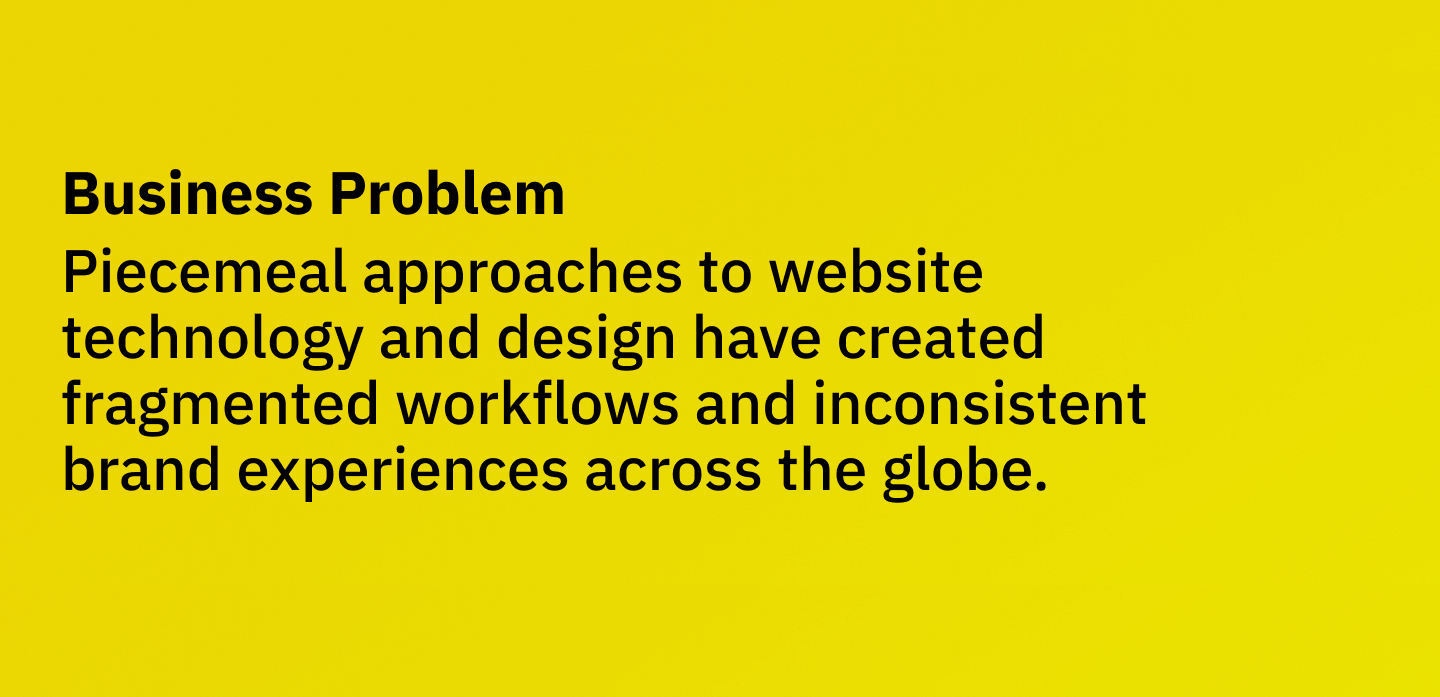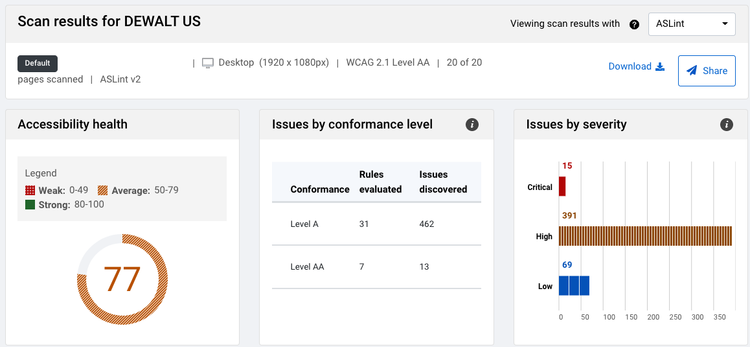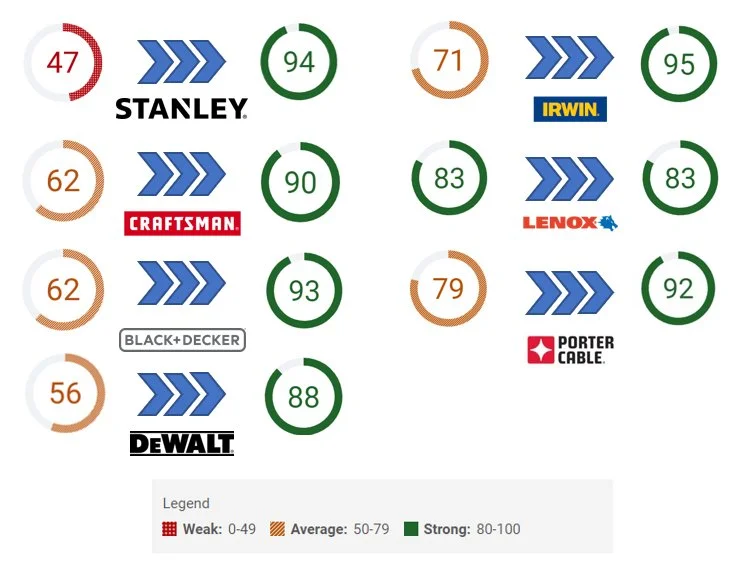Stanley Black & Decker: Henry
Designing SBD’s Globally Accessible Design System
TL;dr
I led a global UX and digital transformation at Stanley Black & Decker—building their first design system and creating the foundation for scalable, accessible, and faster digital experiences across 7+ brands and four international markets.
Initiative Goals:
Reduce development costs and launch timelines for brand sites
Establish unified brand standards across international markets
Enable brand teams to manage content while maintaining brand design and experience standards
Improve accessibility across all sites to meet compliance and boost usability standards
What We Did:
Launched Stanley Black & Decker’s first global design system (Henry), streamlining digital brand experiences across 4+ markets
Increased accessibility scores by an average of 50%, bringing all sites into WCAG 2.1 AA compliance
Avoided $1.2M+ in ADA-related legal costs, mitigating risk and future-proofing the brand portfolio
Integrated with CMS, DAM, and PIM systems to simplify the design system and reduce site creation timelines by 35% (~9 weeks saved per launch)
Delivered $50K–$100K in dev savings per site through reusable UX patterns, reduced QA effort, and accelerated deployment
Equipped global content teams with intuitive design tools and flexible templates for faster, on-brand publishing
Fostered cross-functional alignment between design, development, and content teams through scalable systems and shared governance
Overview
Hired within the Global Customer Experience division to support a re-platform and redesign initiative for all Stanley Black & Decker (SBD) brand websites, I led a UX team of seven researchers, designers, and engineers in developing the strategy, principles, user interface, and design system for the content ecosystem.
This ambitious program was intended to establish a global-first approach and provide equitable access internally to content management and marketing tools across markets. Enhancing user experience and content flexibility while reducing development costs and turnaround times.
Generating Buy-In and Adoption:
As a new team with a large task ahead of us, it was important to bring all of our brands along with the work we were doing. I coordinated with the brand and marketing teams across SBD to conduct audits of our (eventual) legacy brand sites to gain consensus on a core library of patterns, structures, and styles essential to the comprehensive design of global websites.
Standardizing the system
The culmination of our work was the creation and implementation of a cohesive design system. This global framework was developed in collaboration with brand teams and content managers to ensure consistency and scalability across Stanley Black & Decker’s diverse portfolio. We trained localized teams to maintain and adapt the design system, reinforcing our UX principles on a global scale.
Evangelizing Usability and Accessibility
Shoring up accessibility standards was a major organization-wide initiative I spearheaded. Including recruiting strategic vendor partners to fix the over 300k+ missing alt-tags on all brand product and promo imagery, implementing global accessibility targets, and developing educational programs and campaigns to embed accessible practices as an expectation internally, especially for all design and content teams.
The implementation of qualitative and quantitative methods to measure the accessibility of all SBD sites, along with the integration of tools like Hotjar ensured a robust, data-driven approach to our design, user insights the intent focus on building a research roadmap and incorporating usability testing into the design process, ensured our UX designs met a high standard of accessibility and human-centered design.
Final Impact
Our Global UX team’s dedicated work to build this system was a significant accomplishment.
In a short period, we transformed Stanley Black & Decker’s UX landscape, moving from a fragmented model to one that, although imperfect, valued collaboration, accessibility, and research. This was demonstrated through the release of a design system based on human-centered principles, which met both business and user needs. Through dedicated team building, cross-functional collaboration, and a relentless focus on accessibility and usability, we laid the groundwork for a sustainable UX future across the organization.
Project Details:
Organization: Stanley Black & Decker
Initiative: Global Web Migration, Experience Design, and Content/Asset Platform Integration
Role: Global UX Manager
Timeline: September 2020 – January 2022
Markets Served: North America, ANZ (Australia & New Zealand), EMEA (Europe, Middle East & Africa), LAG (Latin America Group), ASIA
Systems Integrated: Drupal (CMS), Bynder (DAM), Riversand (PIM)
Stakeholders Collaborated With:
Global Marketing, Brand, and eCommerce Leadership
Engineering, IT, and Legal/Compliance Teams
Regional Executives and International VPs
3rd-Party Vendors (Development, Accessibility, Platform Integration)
Team Led:
Sr. UX Designer
Lead UX Engineer
Lead Accessibility Designer
UX Designer
UX Strategist
UX Researchers (2)
Key Takeaways
Advocating for UX requires persistence. Demonstrating the business value of design and research takes consistent effort and alignment. Find the story that connects UX to business goals, and tell it often.
Design leadership isn’t always pretty. Staying true to human-centered principles is slow, often thankless work. Expect bruises, build thick skin, and lead with clarity anyway.
Cross-functional collaboration is everything. Involving design, development, content, and strategy teams early creates shared understanding and reduces delays down the line.
A clear UX vision is a force multiplier. Documented standards and scalable processes were a game-changer—providing structure, setting expectations, and enabling sustainable growth.
Ego has a place—but so does humility. Knowing when to step forward and when to step back is key to building trust, keeping teams honest, and staying grounded in the work.























